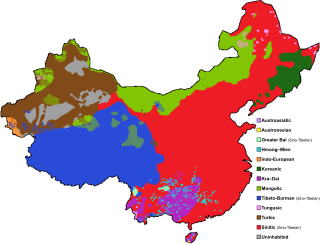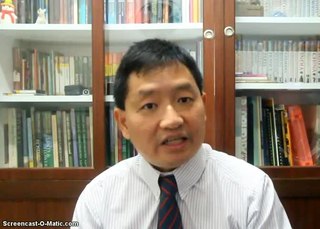
Standard Chinese is a modern standard form of Mandarin Chinese that was first codified during the republican era (1912–1949). It is designated as the official language of mainland China and a major language in the United Nations, Singapore, and Taiwan. It is largely based on the Beijing dialect. Standard Chinese is a pluricentric language with local standards in mainland China, Taiwan and Singapore that mainly differ in their lexicon. Hong Kong written Chinese, used for formal written communication in Hong Kong and Macau, is a form of Standard Chinese that is read aloud with the Cantonese reading of characters.
Manglish is an informal form of Malaysian English with features of an English-based creole principally used in Malaysia. It is heavily influenced by the main languages of the country, Malay, Tamil, and varieties of Chinese. It is not one of the official languages spoken in Malaysia.
Singapore English is the set of varieties of the English language native to Singapore. In Singapore, English is spoken in two main forms: Singaporean Standard English, which is indistinguishable grammatically from British English, and Singaporean Colloquial English, which is better known as Singlish.

There are several hundred languages in China. The predominant language is Standard Chinese, which is based on Beijingese, but there are hundreds of related Chinese languages, collectively known as Hanyu, that are spoken by 92% of the population. The Chinese languages are typically divided into seven major language groups, and their study is a distinct academic discipline. They differ as much from each other morphologically and phonetically as do English, German and Danish, but meanwhile share the same writing system (Hanzi) and are mutually intelligible in written form. There are in addition approximately 300 minority languages spoken by the remaining 8% of the population of China. The ones with greatest state support are Mongolian, Tibetan, Uyghur and Zhuang.

Penang Hokkien is a local variant of Hokkien spoken in Penang, Malaysia. It is spoken natively by 63.9% of Penang's Chinese community, and also by some Penangite Indians and Penangite Malays.

Chinese Singaporeans are Singaporeans of Han Chinese ancestry. Chinese Singaporeans constitute 75.9% of the Singaporean resident population according to the official census, making them the largest ethnic group in Singapore.
The following lists events that happened during 1994 in Singapore.
The following lists events that happened during 1988 in Singapore.
The Speak Mandarin Campaign is an initiative by the Government of Singapore to encourage the Chinese Singaporean population to speak Standard Mandarin Chinese, one of the four official languages of Singapore. Launched on 7 September 1979 by then Prime Minister Lee Kuan Yew and organised by the Promote Mandarin Council, the SMC has been an annual event promoting the use of Mandarin.

The languages of Singapore are English, Chinese, Malay and Tamil, with the lingua franca between Singaporeans being English, the de facto main language. Singaporeans often speak Singlish among themselves, an English creole arising from centuries of contact between Singapore's internationalised society and its legacy of being a British colony. Linguists formally define it as Singapore Colloquial English. A multitude of other languages are also used in Singapore. They consist of several varieties of languages under the families of the Austronesian, Dravidian, Indo-European and Sino-Tibetan languages. The Constitution of Singapore states that the national language of Singapore is Malay. This plays a symbolic role, as Malays are constitutionally recognised as the indigenous peoples of Singapore, and it is the government's duty to protect their language and heritage.
Malaysian Mandarin is a variety of the Chinese language spoken in Malaysia by ethnic Chinese residents. It is currently the primary language used by the Malaysian Chinese community
Singlish is the English-based creole or patois spoken colloquially in Singapore. English is one of Singapore's official languages, along with Malay, Mandarin, and Tamil. Although English is the lexifier language, Singlish has its unique slang and syntax, which are more pronounced in informal speech. It is usually a mixture of English, Hokkien, Cantonese, Malay, and Tamil, and sometimes other Chinese languages like Teochew, Hainanese, Hakka, Hockchew, and Mandarin. For example, pek chek means to be annoyed or frustrated, and originates from Singaporean Hokkien 迫促. It is used in casual contexts between Singaporeans, but is avoided in formal events when certain Singlish phrases may be considered unedifying. Singapore English can be broken into two subcategories: Standard Singapore English (SSE) and Colloquial Singapore English (CSE) or Singlish as many locals call it. The relationship between SSE and Singlish is viewed as a diglossia, in which SSE is restricted to be used in situations of formality where Singlish/CSE is used in most other circumstances.
Singaporean Mandarin is a variety of Mandarin Chinese spoken natively in Singapore. Mandarin is one of the four official languages of Singapore along with English, Malay and Tamil.
Singaporean Hokkien is a local variety of the Hokkien language spoken natively in Singapore. Within Chinese linguistic academic circles, this dialect is known as Singaporean Ban-lam Gu. It bears similarities with the Amoy spoken in Amoy, now better known as Xiamen, as well as Taiwanese Hokkien which is spoken in Taiwan.

Singlish, formally known as Colloquial Singaporean English, is an English-based creole language originating in Singapore. Singlish arose out of a situation of prolonged language contact between speakers of many different Asian languages in Singapore, such as Malay, Cantonese, Hokkien, Mandarin, Teochew, and Tamil. The term Singlish was first recorded in the early 1970s. Manglish spoken in peninsula Malyasia is similar and largely mutually inteligible.
Singaporean Hokkien is the largest non-Mandarin Chinese dialect spoken in Singapore. As such, it exerts the greatest influence on Colloquial Singaporean Mandarin, resulting in a Hokkien-style Singaporean Mandarin widely spoken in the country.
Standard Singaporean Mandarin is the standard form of Singaporean Mandarin. It is used in all official Chinese media, including all television programs on Channel 8 and Channel U, various radio stations, as well as in Chinese lessons in all Singapore government schools. The written form of Chinese used in Singapore is also based on this standard. Standard Singaporean Mandarin is also the register of Mandarin used by the Chinese elites of Singapore and is easily distinguishable from the Colloquial Singaporean Mandarin spoken by the general populace.
Mandarin Chinese is the primary formal Chinese language taught academically to students in Chinese Filipino private schools and additionally across other private and public schools, universities, and institutions in the Philippines, especially as the formal written Chinese language.
In Singapore, language planning is associated with government planning. In this top-down approach, the government influences the acquisition of languages and their respective functions within the speech community through the education system. Language planning aims to facilitate effective communication within the speech community, which can result in a language shift or language assimilation. The goals of language planning are very much dependent on the political and social forces present in Singapore during two distinct periods: Colonisation by the British and the Post-Independence period after 1965.
The usage of Chinese by the Chinese diaspora and their descendants has been determined by a large number of factors, including their ancestry, their migrant ancestors' "regime of origin", assimilation through generational changes, and official policies of their country of residence. The general trend is that more established Chinese populations in the Western world and in many regions of Asia have Cantonese as either the dominant variety or as a common community vernacular, while Mandarin is much more prevalent among new arrivals, making it increasingly common in many Chinatowns, though still not dominant.







